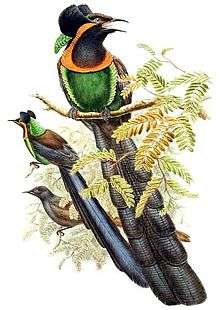Arfak astrapia
| Arfak astrapia | |
|---|---|
 | |
| Illustration of Astrapia nigra. Male (front) and female (behind) | |
| Scientific classification | |
| Kingdom: | Animalia |
| Phylum: | Chordata |
| Class: | Aves |
| Order: | Passeriformes |
| Family: | Paradisaeidae |
| Genus: | Astrapia |
| Species: | A. nigra |
| Binomial name | |
| Astrapia nigra (Gmelin, 1788) | |
The Arfak astrapia (Astrapia nigra) is a species of bird-of-paradise.
In the wild, the bird has hybridised with the black sicklebill creating offspring that were once considered a distinct species, the elliot's sicklebill Epimachus ellioti. While some ornithologists still believe that this bird is a distinct species, possibly critically endangered or even extinct, many now think it was a hybrid between the two species.
Conservation status
Protected by its geographical isolation and undisturbed forests home, the Arfak astrapia is evaluated as Least Concern on the IUCN Red List of Threatened Species. It is listed on Appendix II of CITES.
Description
The Arfak astrapia is large, approximately 76 cm long, black, with an iridescent purple, green and bronze plumage. The male has a very long broad tail, velvety black breast feathers and extremely complex head plumage, although it often appears black. The male displays upside down. The female is a blackish brown with pale barring on its abdomen. The diet consists mainly of pandanus fruits.
Levaillant of France described this bird as L’Incomparable or Incomparable bird-of-paradise.
Distribution
Astrapia nigra is endemic to the Arfak Mountains in Vogelkop Peninsula, West Papua.
References
- ↑ BirdLife International (2012). "Astrapia nigra". IUCN Red List of Threatened Species. Version 2013.2. International Union for Conservation of Nature. Retrieved 26 November 2013.
